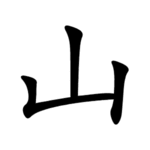Radical 46
| 山 | ||
|---|---|---|
| ||
| 山 (U+5C71) "mountain" | ||
| Pronunciations | ||
| Pinyin: | shān | |
| Bopomofo: | ㄕㄢ | |
| Gwoyeu Romatzyh: | shan | |
| Wade–Giles: | shan1 | |
| Cantonese Yale: | sāan | |
| Jyutping: | saan1 | |
| Pe̍h-ōe-jī: | san | |
| Japanese Kana: | サン san (on'yomi) やま yama (kun'yomi) | |
| Sino-Korean: | 산 san | |
| Names | ||
| Chinese name(s): | (Left) 山字旁 shānzìpáng (Top) 山字頭/山字头 shānzìtóu (Bottom) 山字底 shānzìdǐ | |
| Japanese name(s): | 山/やま yama (Left) 山偏/やまへん yamahen (Top) 山冠/やまかんむり yamakanmuri | |
| Hangul: | 메 me | |
| Stroke order animation | ||
 | ||
Radical 46 or radical mountain (山部) meaning "strokes. It is found in the names of mountains generally in east Asia.
In the radical.
山 is also the 39th indexing component in the Table of Indexing Chinese Character Components predominantly adopted by Simplified Chinese dictionaries published in mainland China.
In Taoist cosmology, 山 (mountain) is the nature component of the bagua diagram 艮 gèn. This diagram corresponds to the I Ching trigram ☶.
Evolution
-
Oracle bone script character
-
Bronze script character
-
Large seal script character
-
Small seal script character
| Strokes | Characters |
|---|---|
| +0 | 山 |
| +1 | 乢 (=蓋 -> 艸) 屲 |
| +2 | 屳 屴 屵 屶JP (also obsolete variant form of 會 -> 曰) 屷 (=會 -> 曰) |
| +3 | 屸 屹 屺 屻 屼 屽 屾 屿SC (=嶼) 岀 (=出 -> 凵) 岁SC (=歲) 岂SC (=豈) 岃 |
| +4 | 岄 岅 (=阪 -> 阜) 岆 岇 岈 岉 岊 岋 岌 岎 岏 岐 岑 岒 岓 岔 岕 岖SC (=嶇) 岗SC (=崗) 岘SC (=峴) 岙SC (=嶴) 岚SC (=嵐) 岛SC (=島) 岜 |
| +5 | 岝 岞 岟 岠 岡 岢 岣 岤 岥 岦 岧 岨 岩 岪 岫 岬 岭SC (=嶺) 岮 岯 岰 岱 岲 岳 岴 (=嶇) 岵 岶 岷 岸 岹 (=岧) 岺 岻 岼 岽SC (=崬) 岾 岿SC (=巋) 峀 峁 峂 峃SC (=嶨) 峄SC (=嶧) 峅JP |
| +6 | 岍 峆 峇 峈 峉 峊 峋 峌 峍 峎 峏 峐 峑 峒 峓 峔 峕 (=時 -> 日) 峖 峗 峘 峙 峚 峛 峜 峝 (=峒) 峞 峟 峠JP 峡SC/JP (=峽) 峢 (=峛) 峣SC (=嶢) 峤SC (=嶠) 峥SC (=崢) 峦SC (=巒) 峧 |
| +7 | 峨 峩 (=峨) 峪 峫 峬 峭 峮 峯HK variant (=峰) 峰 峱 峲 峳 峴 峵 島 峷 峸 峹 峺 峻 峼 峽 峾 峿 崀 崁 崂SC (=嶗) 崃SC (=崍) 崄SC (=嶮) 崅 |
| +8 | 崆 崇 崈 (=崇) 崉 崊 崋 崌 崍 崎 崏 崐 (=崑) 崑 崒 崓 崔 崕 (=崖) 崖 崗 崘 (=崙) 崙 崚 崛 崜 崝 崞 崟 崠 崡 崢 崣 崤 崥 崦 崧 崨 崩 崪 崫 崬 崭SC (=嶄) 崮 崯 崰 |
| +9 | 崱 崲 崳 崴 崵 崶 崷 崸 崹 崺 崻 (=峙) 崼 崽 崾 崿 嵀 嵁 嵂 嵃 嵄 嵅 嵆 嵇 嵈 嵉 嵋 嵌 嵍 嵎 嵏 嵐 嵑 嵒 (=岩) 嵓 (=岩) 嵔 嵕 嵖 嵗 (=歲 -> 止) 嵘SC (=嶸) 嵙 嵚SC (=嶔) 嵛 嵜 (=崎) 嵝SC (=嶁) |
| +10 | 嵊 嵞 嵟 嵠 嵡 嵢 嵣 嵤 嵥 嵦 嵧 嵨 嵩 嵪 嵫 嵬 嵭 嵮 嵯 嵰 嵱 嵲 嵳 嵴 嵵 嵶 |
| +11 | 嵷 嵸 嵹 嵺 嵻 嵼 嵽 嵾 嵿 嶀 嶁 嶂 嶃 (=嶄) 嶄 嶅 嶆 嶇 嶈 嶉 嶊 嶋 (=島) 嶌 (=島) 嶍 嶎 |
| +12 | 嶏 嶐 嶑 嶒 嶓 嶔 嶕 嶖 嶗 嶘 嶙 嶚 (=嶛) 嶛 嶜 嶝 嶞 嶟 嶠 嶡 嶢 嶣 嶤 嶥 |
| +13 | 嶦 嶧 嶨 嶩 (=峱) 嶪 嶫 嶬 嶭 嶮 嶯 嶰 嶱 嶲 嶳 嶴 嶵 嶶 |
| +14 | 嶷 嶸 嶹 嶺 嶼 嶽 嶾 嶿 |
| +15 | 巀 巁 巂 |
| +16 | 嶻 巃 巄 (=巃) 巅SC (=巔) |
| +17 | 巆 巇 巈 巉 巊 巋 巌JP (=巖) |
| +18 | 巍 巏 巐 |
| +19 | 巎 巑 巒 巓 (=巔) 巔 巕 巗 (=巖) |
| +20 | 巖 巘 巙 巚 (=巘) |
Sinogram
The radical is also used as an independent
Chinese character. It is one of the Kyōiku kanji or Kanji taught in elementary school in Japan.[1] It is a first grade kanji[1]
References
- ^ a b "The Kyoiku Kanji (教育漢字) - Kanshudo". www.kanshudo.com. Archived from the original on March 24, 2022. Retrieved 2023-05-06.
Literature
- Fazzioli, Edoardo (1987). Chinese calligraphy : from pictograph to ideogram : the history of 214 essential Chinese/Japanese characters. calligraphy by Rebecca Hon Ko. New York: ISBN 0-89659-774-1.
- Lunde, Ken (Jan 5, 2009). "Appendix J: Japanese Character Sets" (PDF). CJKV Information Processing: Chinese, Japanese, Korean & Vietnamese Computing (Second ed.). ISBN 978-0-596-51447-1.
See also
- Xian (Taoism)
- List of mountains in China
- List of mountains in Japan
- List of mountains in Korea
External links
Wikimedia Commons has media related to Radical 046.




